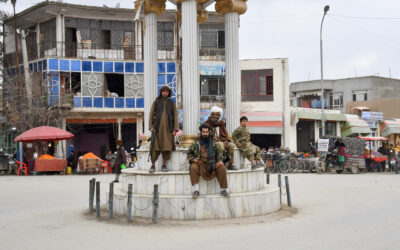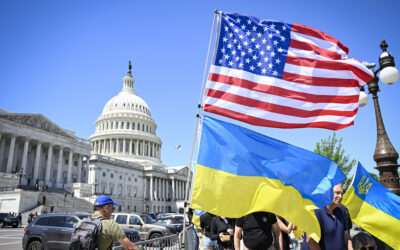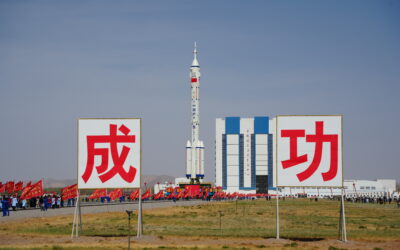OPINION — As we await the Biden 2022 Nuclear Posture Review (NPR) and the results of U.S.-Russian security talks that opened yesterday in Geneva, it’s time to review some of the ‘doublethink’ that nuclear weapons have generated over the past 77 years using George Orwell’s word from his novel, 1984.
That idea came to me after reading the January 3, “Joint Statement from the Leaders of the Five Nuclear-Weapon States on Preventing Nuclear War and Avoiding Arms Races,” put out by the People’s Republic of China, the French Republic, the Russian Federation, the United Kingdom and the United States.
Those five countries, each of whom is in the process of modernizing and upgrading the lethality, or increasing the warhead numbers in its nuclear arsenal, began their joint statement by saying, “We affirm that a nuclear war cannot be won and must never be fought.”
It’s a great slogan, but if you really mean it, why build more nuclear weapons?
‘Doublethink’, according to Orwell, gives one, “the power of holding two contradictory beliefs in one’s mind simultaneously, and accepting both of them.”
Apparently, increasing the power or number of nuclear weapons challenges is another goal mentioned in the Joint Statement, “We also affirm that nuclear weapons—for as long as they continue to exist—should serve defensive purposes, deter aggression, and prevent war.”
We know the Joint Statement from January 3, was just window dressing to satisfy the needs of the five countries that are the original nuclear powers under the 1968 Nuclear Non-Proliferation Treaty (NPT). The NPT’s Article VI requires these nuclear-armed nations “to pursue negotiations in good faith on effective measures relating to cessation of the nuclear arms race at an early date and to [total] nuclear disarmament.”
January 4 was to be the beginning of the month-long, Tenth Review Conference of the Parties to the NPT in New York City, but the conference, which originally was to take place in 2020, was again postponed due to the COVID-19 pandemic and rescheduled for later in 2022.
The NPT Review Conference, which is supposed to take place every five years, is always an embarrassment for the five original nuclear powers and especially the U.S. and Russia, each of which maintains more than 3,000 nuclear warheads. It’s an embarrassment because Article VI of the NPT requires the “total elimination of their nuclear arsenals.”
At the 2019 preparatory conference to the now-postponed Tenth Review Conference, the chairman of that group reported that, “Deep concern was expressed regarding the slow pace of progress towards disarmament and the lack of progress by the nuclear-weapon States to accomplish the total elimination of their nuclear arsenals, in accordance with their relevant multilateral obligations.”
While the NPT Conferences show one element of the ‘doublethink’ surrounding nuclear weapons, the RAND Corporation’s report, Modernizing the U.S. Nuclear Triad: The Rationale for a New Intercontinental Ballistic Missile shows others. Released January 4, it was co-written by Frank G. Klotz, former Administrator of the National Nuclear Security Administration who previously had been Commander of Air Force Global Strike Command, and RAND’s Alexandra T. Evans.
The Cipher Brief hosts private briefings with the world’s most experienced national and global security experts. Become a member today.
The authors say, “Every NPR [U.S. Nuclear Posture Review] conducted since the practice began in 1993 has concluded that maintaining a mix of delivery systems, each possessing different characteristics and attributes, enhances strategic stability by ensuring that no adversary can (or believes it can) conduct a successful disarming first strike and thereby eliminate the United States’ ability to respond to a nuclear attack.”
Fear of the so-called “disarming first strike” has been the basis of U.S. nuclear strategy and generator for the numbers and types of U.S. nuclear weapons deployed since 1946, when that notion emerged out of the American Operation Crossroads tests of two atomic bombs at Bikini Atoll in the Pacific.
During the Cold War, the potential of a Soviet “disarming first strike” on the U.S. was regularly discussed among American strategists and policymakers but in truth, the first strike concept originated with the American military in the wake of those 1946 Bikini tests, and with the Pearl Harbor surprise attack fresh in mind.
The Joint Chiefs of Staff Evaluation Board for Operation Crossroads, in its June 1947 final report, entitled, The Evaluation of the Atomic Bomb as a Military Weapon, wrote, “With the advent of the atomic bomb, surprise has achieved supreme value so that an aggressor, striking suddenly and unexpectedly with a number of atomic bombs might, in the first assault upon his vital targets, achieve such an order of advantage as would insure the ultimate defeat of an initially stronger adversary.”
Later in the report, the Board said, “Offensive measures will be the only generally effective means of defense, and the United States must be prepared to employ them before a potential enemy can inflict significant damage upon us.”
Back in 1947, “offensive measures” as related to nuclear bombs meant using them as they were used in Japan, as terror weapons against military and nearby civilian targets to kill and wound as many people as possible and thus end, or prevent a war.
After 1949, when the Soviet Union first tested its own nuclear weapons, American strategists in the mid-1950s began to worry that Moscow’s development of a hydrogen bomb would endanger America’s strategic bomber force.
The new RAND report said, “The development of the hydrogen bomb, coupled with improvements in the range, precision, and quantity of Soviet missile systems, weakened U.S. strategists’ confidence in the bomber force’s ability to survive a pre-emptive first strike, thereby undermining a fundamental precept for maintaining deterrence. This concern led to calls for more-secure, survivable nuclear forces.”
As a result, in the mid-1950s, U.S. ICBMs “were initially developed to deter a massive Soviet surprise attack intended to disarm the United States and raise the prospect of its destruction or capitulation. Mitigating this risk required a survivable force that could hold numerous and varied Soviet targets at risk and be launched within minutes of warning. Such a force would confront the Soviets or any other adversary contemplating a first strike on the United States or its allies with an unattractive choice: either expend hundreds of its missiles to destroy hundreds of U.S. ICBMs in widely dispersed, hardened silos or face the prospect of an unpalatable costly counterattack on its homeland,” according to the RAND report.
During that same time, the U.S. Navy began developing not just a submarine that could launch an intercontinental missile, but also a missile that could itself be launched from a submerged sub anywhere in the world and with guidance from satellites, could hit its pre-programmed target.
Thus, the U.S. created the Triad, the ability to deliver strategic nuclear weapons on the Soviet Union or any other threatening country by strategic bombers, ground-based ICBMs or sub-launched SLBMs.
Go beyond the headlines with expert perspectives on today’s news with The Cipher Brief’s Daily Open-Source Podcast. Listen here or wherever you listen to podcasts.
As the RAND study put it, “The survivability of U.S. nuclear forces [from a first strike] can best be ensured by maintaining a mix of nuclear delivery systems, each of which complements the others’ attributes and compensates for any vulnerabilities or technical failures of the others.”
As years went on, the U.S. goal advanced from just survivability of U.S. nuclear forces to having so many such weapons that a first strike could be absorbed and there would still be enough remaining nuclear weapons to deliver a massive nuclear counterattack on the aggressor.
The RAND report described this as “the calculation that the United States can best deter aggression and achieve strategic stability by maintaining nuclear forces capable of surviving a nuclear attack and retaliating in a way that denies the attacker its objectives and imposes devastating consequences in the process.”
Here is another case of Orwell’s doublethink. The U.S. built up so many nuclear warheads as a defense against an imagined Soviet first strike, that it created fear in Moscow that it was the Americans who were planning a first strike on the Soviet Union.
From the 1960s to the mid-1980s, the U.S. and Russian nuclear arsenals each grew to over 30,000 weapons, before both Washington and Moscow moved seek reductions through arms control negotiations.
On both sides, it was a recognition that the nuclear arms race had gotten out of hand amid fears that a mistaken launch could lead to nuclear war.
By 2013, the State Department was able to announce that the U.S. nuclear arsenal had been cut from its highpoint by 85 percent, yet there were still 1,550 warheads and bombs on deployed strategic delivery systems and another roughly 4,000 weapons in reserve. Russian strategic nuclear stockpiles had experienced similar reductions although Moscow retained more than 2,500 tactical nuclear weapons as opposed to the U.S. continuing to have less than 1,000.
The RAND study has recognized that the threat of a bolt-from-the-blue attack has diminished since the end of the Cold War but nonetheless, the authors worried that the “continued erosion of U.S. capabilities could undermine deterrence stability by creating a perception of U.S. vulnerability.”
Referring to the fact that “both Russia and China continue to modernize, diversify, and expand their respective nuclear arsenals and other adversaries pursue nuclear-related activities,” the RAND report said, “the number and types of targets that U.S. nuclear forces might need to hold at risk to deter an adversary’s use of nuclear weapons in a crisis or conflict are changing—and can be expected to continue to change in complex and unpredictable ways over the next several decades.”
In short, the RAND report is back to seeing nuclear weapons as needing to target potential enemy nuclear weapons, resurrecting the first strike myth, while forgetting the real role of such terror weapons was to kill and wound as many people as possible to end a war.
If, as the five nuclear powers last week claimed, “A nuclear war cannot be won and must never be fought,” is it not time to further reduce nuclear weapons and perhaps have a race in developing defensive systems against them?
And by the way, try to cut out all the nuclear ‘doublethink’.
Read more expert-driven national security insight, perspective and analysis in The Cipher Brief
Disclaimer – The Cipher Brief participates in the Amazon Affiliate program and may make a small commission from purchases made via links.










